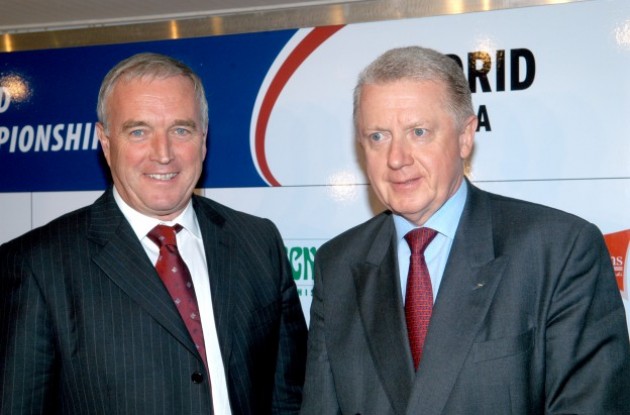Chipping away at Omertà
Omertà is defined as a rule or code that prohibits speaking or divulging information about certain activities, especially the activities of a criminal organization. The word is often used when speaking about the Mafia and their code of silence. As we know omertà hasn’t been used exclusively by criminal organizations, but by sporting ones as well.
How does an omertà work? A rational person would think that if a crime has been committed against a person, this person would alert the authorities. Instead nothing is reported and the crime gets buried deeper and deeper until it becomes part of the fabric of the organization. The reason the crime gets buried is the person who commits the crime has more power than the organization that is supposed to police it.
The always blunt David Millar in an interview with The Guardian published yesterday said that until recently cycling has been, “a deeply criminal business.”
An often used example of omertà in cycling is when Lance Armstrong in the 18th stage of the 2004 Tour de France chased down Italian Filippo Simeoni’s breakaway – effectively killing its chances of survival. To appease Armstrong, Simeoni was told by his fellow breakaway companions to drop out of the break and return to the peloton. Once back in the main group he was verbally abused.
Simeoni testified that Armstrong claimed he could destroy him. Speaking on Italian radio Simeoni said, “(Armstrong) was in charge of cycling, and nothing was done."
Why nothing was done and how omertà thrives is simple to me – the governing/federation body is either corrupt or incompetent.
To be fair Armstrong and team director Johan Bruyneel didn’t create omertà - they just had the power to make it happen. And that’s one of the most common questions I was asked during the flurry of interviews I did after the USADA report was released (most common question: why is he guilty of doping if he’s never failed a doping test?).
The now disgraced rider rose to power when the sport was still reeling from the 1998 Tour de France. The Festina doping scandal rocked the sport and peeled away a layer of what was going on behind the closed hotel doors of cycling teams. In the end the Festina squad was kicked out of the Tour de France and Spanish squads also quit the race in protest. In the end Marco Pantani won what was called the Tour du Dopage with Jan Ullrich second and American Bobby Julich third.
While we can look back with hindsight now, in those days we couldn’t see the forest that is institutionalized doping through the trees of the Festina squad. That year’s podium exemplified this – Pantani was expelled from the 1999 Giro d’Italia for doping and died of a cocaine overdose in 2004. Ullrich’s name has been tied to Operation Puerto and he is widely considered to have doped throughout his career. Recently Julich stated that he had doped up until July of 1998.
In his confession he states, “the use of EPO in the peloton was so casual and accepted that I personally lost perspective of the gravity of the situation.”
With the ‘98 Tour in the history books no one thought that team-wide organized doping could occur again. It was far too risky as France had criminalized doping. The attitude was that the 1999 Tour de France was a rebirth and that was exactly what the event needed. However, Bruyneel took institutionalized doping to a new level. The UCI couldn’t afford another huge doping scandal two years in a row so they relinquished control of the sport to Armstrong and his cronies.
This shift in power was done piece by piece: allowing a backdated therapeutic use exemption (TUE) for cortisone during the 1999 Tour to a $100,000 “donation” to the UCI in 2002 which Armstrong claimed to be for a better anti-doping machine. Tyler Hamilton, Floyd Landis and Levi Leipheimer claim that it was a payment to cover up a positive doping result at the 2001 Tour of Switzerland.
Piece by piece the legitimacy of professional cycling was stripped away. In an interview with the newspaper Scotland on Sunday Graeme Obree recalls how in a 1996 interview with L’Equipe he claimed that 99% of the riders were doping. Hein Verbruggen, the UCI president, called him a coward.
Current UCI president Pat McQuaid said that those who have recently stepped up to admit their doping past are “scumbags.” McQuaid and Verbruggen had even started legal proceedings against journalist Paul Kimmage, which are now suspended in what appears to be an effort to shut up the outspoken critique of the UCI.
“It was a Pandora’s box. If Verbruggen opened it, there would have been nothing left in the sport, so he kept it closed," is how Obree describes those times. And those times still exist today keeping a form of omertà alive.
What kind of leaders squashes down this type of information unless they are themselves trying to keep a lid on the whole dirty organization?
With King Armstrong’s power gone other riders have started to step up and talk about those dirty days. Some are sharing stories of how they made the choice to quit cycling or leave professional cycling rather than be a part of doping. Again, chipping away at the culture of omertà.
With Armstrong gone one part of the omertà equation has ended, but the other remains – McQuaid and Verbruggen. To fully embrace the change that must happen for professional cycling to regain its legitimacy as a sport these two must go. I am convinced they have at the minimum been complicit or at the worst been making money from covering up doping.
Just when I think of wrapping this column up, Velonews is reporting that the International Association of Professional Cycling teams (AIGCP) voted to support a proposal for an independent review of cycling’s anti-doping program. This is another vital step in stripping away the traces of omertà. Too long has anti-doping been closely tied to the UCI – it needs to be independent with the World Anti-Doping Agency (WADA) having ultimate power.
As Vaughters tells Velonews, “Is there the possibility of cover-up? ... A lot of those problems can be solved by moving the anti-doping under a different roof” This different roof needs to be far away from the UCI.
There will always be the possibility of omertà affecting our sport. However, the sport is slowly making the code of silence harder to maintain. Armstrong is out and only Bruyneel remains, like a vestigial organ, from the Postal Team gang. Organizationally the leaders of the UCI are feeling the heat from the AIGCP as well as the public. The Support Kimmage fund (now at over US$90,000) that is found on NYVelocity and Cyclismas is an example of the lack of faith the general public has in the UCI. These final steps in removing omertà completely will come from the younger generation of riders. To them institutionalized doping will no longer be the norm but rather the exception.








